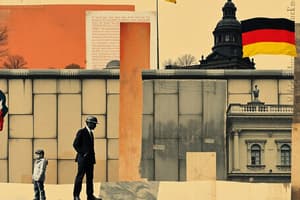Podcast
Questions and Answers
What was a significant result of the fall of the Berlin Wall?
What was a significant result of the fall of the Berlin Wall?
- It marked the beginning of the Cold War.
- It isolated Eastern European countries from Western Europe.
- It caused the disintegration of the European Community.
- It led to the reunification of Germany. (correct)
What was a major concern for France and the UK regarding German reunification?
What was a major concern for France and the UK regarding German reunification?
- The financial instability of Germany.
- The emergence of a dominant Germany in Europe. (correct)
- The potential destabilization of Eastern Europe.
- The strengthening of communist regimes in Eastern Europe.
Which philosopher declared the triumph of democratic liberalism after the collapse of communism?
Which philosopher declared the triumph of democratic liberalism after the collapse of communism?
- Francis Fukuyama (correct)
- Friedrich Nietzsche
- John Stuart Mill
- Karl Marx
What type of clashes erupted in Transylvania, Romania, in March 1990?
What type of clashes erupted in Transylvania, Romania, in March 1990?
Which cultural reference was used in George Bush Sr.'s election campaign to reflect a sense of optimism?
Which cultural reference was used in George Bush Sr.'s election campaign to reflect a sense of optimism?
What challenges do women still face in the workforce despite gaining equal rights under the law?
What challenges do women still face in the workforce despite gaining equal rights under the law?
What characterized the financial and economic crises in Germany following reunification?
What characterized the financial and economic crises in Germany following reunification?
What was a result of the end of the Cold War regarding Eastern European countries?
What was a result of the end of the Cold War regarding Eastern European countries?
What significant document was established in 1948 to affirm equal political rights for women?
What significant document was established in 1948 to affirm equal political rights for women?
Which of the following challenges does the feminist movement face according to the content?
Which of the following challenges does the feminist movement face according to the content?
What was one of the main effects of the availability of contraceptives in the 1960s?
What was one of the main effects of the availability of contraceptives in the 1960s?
What impact did Simone de Beauvoir's work 'The Second Sex' have on feminism?
What impact did Simone de Beauvoir's work 'The Second Sex' have on feminism?
Which social movement was highlighted for its achievements and challenges in the context of women's rights?
Which social movement was highlighted for its achievements and challenges in the context of women's rights?
How has globalization affected local cultures according to the content?
How has globalization affected local cultures according to the content?
What role did women begin to take on within democratic policies as mentioned in the content?
What role did women begin to take on within democratic policies as mentioned in the content?
What type of fundamentalism is discussed in relation to globalization?
What type of fundamentalism is discussed in relation to globalization?
What was the shift in feminist solidarity observed by the end of the 20th century?
What was the shift in feminist solidarity observed by the end of the 20th century?
Which region was noted for implementing measures like state support for maternity and public childcare as part of the struggle for gender equality?
Which region was noted for implementing measures like state support for maternity and public childcare as part of the struggle for gender equality?
What is a major cause of the persistence of the gender pay gap?
What is a major cause of the persistence of the gender pay gap?
How did feminists view the relationship between gender oppression and non-heterosexual rights?
How did feminists view the relationship between gender oppression and non-heterosexual rights?
What challenges do women face in the private sector compared to the public sector?
What challenges do women face in the private sector compared to the public sector?
What additional actions are necessary in the fight against gender violence?
What additional actions are necessary in the fight against gender violence?
Which of the following measures can help address the gender pay gap?
Which of the following measures can help address the gender pay gap?
In regions where women have more rights, such as in Sweden, what trend has been observed among women regarding employment?
In regions where women have more rights, such as in Sweden, what trend has been observed among women regarding employment?
What do fundamentalist movements primarily demand concerning religious texts?
What do fundamentalist movements primarily demand concerning religious texts?
What is one of the primary goals of fundamentalist movements in regard to the state?
What is one of the primary goals of fundamentalist movements in regard to the state?
How do fundamentalists generally react to Western modernism?
How do fundamentalists generally react to Western modernism?
In what way do some religious leaders within fundamentalist movements gain influence?
In what way do some religious leaders within fundamentalist movements gain influence?
Despite their opposition to modernity, how do fundamentalists often disseminate their beliefs?
Despite their opposition to modernity, how do fundamentalists often disseminate their beliefs?
What significant change was made regarding married women's legal status in several European countries?
What significant change was made regarding married women's legal status in several European countries?
What landmark case in 1973 recognized women's privacy rights regarding pregnancy decisions in the USA?
What landmark case in 1973 recognized women's privacy rights regarding pregnancy decisions in the USA?
Which of the following has NOT been a focus of the international feminist movement after WWII?
Which of the following has NOT been a focus of the international feminist movement after WWII?
What has contributed to the alignment of professional biographies of men and women in recent years?
What has contributed to the alignment of professional biographies of men and women in recent years?
What has been the impact of the Yogyakarta Principles?
What has been the impact of the Yogyakarta Principles?
How has family structure changed in Europe since 1989?
How has family structure changed in Europe since 1989?
What primary issue did delegates from developed countries focus on during the 1975 World Conference on Women?
What primary issue did delegates from developed countries focus on during the 1975 World Conference on Women?
What organizations represented the two main factions of the international feminist movement after WWII?
What organizations represented the two main factions of the international feminist movement after WWII?
Flashcards are hidden until you start studying
Study Notes
The Fall of the Berlin Wall and the End of the Cold War
- The fall of the Berlin Wall in 1989 led to the collapse of the communist bloc in Eastern Europe.
- This event facilitated the expansion of the European Community to include several Eastern European countries, such as Poland, Hungary, and Czechoslovakia.
German Reunification: Challenges and Tensions
- The reunification of Germany in 1990 marked the end of the division of Europe, which had persisted since World War II.
- France and the UK, wary of a dominant Germany in Europe, initially expressed hesitations about reunification.
- The USA supported reunification due to concerns about a neutral Germany destabilizing the region.
- The reunification was achieved with certain conditions and reservations, contributing to instability in Europe, as evidenced by Germany's financial and economic crises in the following years.
Instability in Eastern Europe
- The fall of the Berlin Wall and German reunification brought about ethnic tensions in Eastern Europe.
- In March 1990, clashes erupted between Romanians and Hungarians in Transylvania, Romania.
- The disintegration of Yugoslavia fueled concerns about the possibility of further conflicts in the region.
The End of History and the Triumph of Liberalism
- Philosopher Francis Fukuyama argued that the collapse of communism marked the "End of History" and the triumph of democratic liberalism.
- This optimism was reflected in popular culture, such as Bobby McFerrin's hit song "Don't Worry, Be Happy," which signified a sense of well-being and globalization.
The Long March of Women
The Conquest of the Vote
- The right to vote was a significant milestone for women, enabling their participation in elections and political decision-making.
- Despite equal rights under the law and in education, women still faced challenges in achieving equal opportunities in the workforce.
- International law, including the Universal Declaration of Human Rights (1948) and the Convention on the Political Rights of Women (1952), affirmed equal political rights for women.
Consumers and Producers
Women's Rights
- This section explores the historical struggle for women's equality, encompassing their right to vote, participation in the workforce, and sexual freedom.
- It compares the feminist movement in different contexts: capitalist countries, the communist bloc, and the third world, highlighting both achievements and challenges.
Global Movement
- Globalization has had a significant impact on local cultures, fostering individualism and the need for global governance.
Religious Fundamentalism
- This section examines the rise of religious fundamentalism, focusing on Islamic and Christian movements.
- It analyzes the political and social consequences of religious fundamentalism within the context of globalization.
The Struggle for Sexual and Individual Freedom
- This section explores Simone de Beauvoir's work "The Second Sex," which laid the groundwork for a feminist critique of modern society, distinguishing between biological and social constructions of womanhood.
- It examines the diversification of the feminist movement in the 1970s, including feminist organizations within the student left and academic discussions on gender inequality.
- It highlights the increasing inclusion of feminist demands in democratic policies and the emergence of women in leadership roles.
Sexual Revolution
- The availability of contraceptives in the 1960s granted women greater control over reproduction, leading to increased sexual freedom and a challenge to traditional values.
Legal Equality
- Equal rights under civil law were consolidated, including the legal autonomy of married women and the abolition of the "head of the family" concept in several European countries.
Right to Abortion
- The feminist movement advocated for the legalization of abortion, a significant milestone being the Roe vs. Wade case in the USA (1973), recognizing women's right to autonomy over their pregnancies.
Decriminalization of Abortion
- The decriminalization of abortion has gained traction globally, despite opposition from religious organizations, although restrictions remain in certain countries.
Family Homogenization
- Since 1989, Europe has witnessed a homogenization of family models, with an increase in civil unions and births outside of marriage, albeit regional variations.
Individualism and Professionalism
- Professional biographies of men and women have become more aligned, with delays in family formation and motherhood due to economic and political expectations.
Sexual Rights
- Advocacy by feminist and LGBTQ+ groups led to efforts towards legal recognition of sexual diversity. However, inequalities and penalties remain in place in some countries.
Legal Recognition
- Despite advancements such as the Yogyakarta Principles, disparities persist in the recognition of same-sex unions and other related rights around the world.
Gender Equality and Cultural Differences
- The international feminist movement post-WWII was divided into two prominent organizations: the Women's International League for Peace and Freedom (WILF) and the Women's International Democratic Federation (WIDF).
- The UN convened the first World Conference on Women in Mexico City (1975) to address the growing importance of feminist demands.
- Delegates from developed countries focused on issues like abortion and lesbian rights, while representatives from developing countries emphasized economic and social inequalities faced by women.
- Subsequent conferences (Copenhagen 1980, Nairobi 1985, Beijing 1995) fostered greater consensus among feminists from various regions, shifting from "romantic" solidarity to a "strategic" one.
- By the end of the 20th century, there was a greater understanding of the connection between poverty, social inequality, and gender inequality, with increased influence from countries like China, India, and Africa.
- Western Europe and North America implemented measures to promote gender equality, such as state support for maternity, public childcare, paid parental leave, and affirmative action.
- These measures faced opposition from conservative sectors and although adopted by many developed countries, their implementation varies.
- While women have gained greater rights in certain areas, such as Sweden, the gender pay gap persists in many countries, with women earning less than men for the same work.
- Addressing this gap requires implementing equal pay policies, promoting pay transparency, and eliminating gender bias in the workplace.
How was the recognition of non-heterosexual rights incorporated into women’s struggles?
- Recognition of non-heterosexual rights was incorporated into women's struggles through a shared understanding that gender oppression affects not only cisgender heterosexual women.
- The struggles for LGBTQ+ rights became intertwined with feminist struggles due to the interconnectedness of all forms of gender oppression.
- Feminists advocate for equality and justice for all individuals, regardless of their sexual orientation or gender identity, recognizing that gender discrimination affects everyone.
Fundamentalism
Threat to Democracy
- Fundamentalist movements demand a literal interpretation of holy texts across various religious traditions, including Christianity, Catholicism, Hinduism, and Judaism.
- Fundamentalists believe that individual behavior should adhere to religious doctrines and theology, and challenge the "excesses" of Westernization in terms of secularization, individual rights, and freedoms.
- Opposing the Western modernism that promoted a secular culture, they call for a re-confessionalization of the state and encourage religious leaders and believers to participate in political life.
- Fundamentalism refers to rigid adherence to religious principles and beliefs, demanding that sacred writings be applied literally to all aspects of life.
- Some religious leaders have even attained political power, becoming heads of state.
- Religious fundamentalism has emerged in response to globalization, aiming to defend traditional values against modernization.
- Despite their opposition to modernity, fundamentalists often use modern technologies, such as television and the internet, to spread their beliefs and promote a specific religious identity.
- The section emphasizes two prominent forms of religious fundamentalism: Islamic and Christian, whose impact has been significant domestically and internationally in recent decades.
Studying That Suits You
Use AI to generate personalized quizzes and flashcards to suit your learning preferences.




